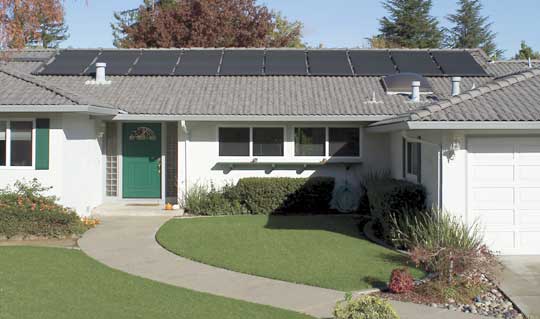Renewable Energy - Part 2 - Solar water heating

Image above courtesy of Viessmann heating systems - Evacuated tube solar panels
- What is solar water heating?
Water is circulated to a panel on the roof, where it is heated. The heated water is then circulated through a calorifier in the water tank serving the home. The solar panels are of three main types for solar water heating in the U.K.
- 01 Evacuated tube
- 02 Flat plate collectors
- 03 Unglazed collectors
- Evacuated tube solar panels
Air is evacuated from the glass tubes to reduce heat loss through convection and radiation. The glass tubes generally contain a dark coloured heat absorbing surface to absorb the heat, and are connected to an inner metal tube. The inner tube can be of two types, a direct flow type, containing a flow and return pipe in which the heat exchange fluid circulates through all the glass tubes in turn, or individual heat pipes. Individual heat pipes contain a small quantity of heat exchange fluid, generally water or alcohol, under reduced pressure, the heat from the sun vaporizes the fluid which rises to a heat exchanger in the manifold, which transfers the heat from all the heat pipes to the water or glycol flowing in the manifold. This fluid is then circulated through a heat exchanger in the hot water tank, to warm water for the home. As evacuated tubes containing heat pipes are all self contained, there is no problem if a single tube needs replacing. Evacuated tube solar heating panels are more efficient than other types, and can raise the heat exchange fluid to very high temperatures. They are however also more expensive than the other types, and care should be taken to avoid water overheating, if the tank is not in use for a period, during hot weather.
- Flat plate collectors
The commonest type of solar heating panel for hot water systems. It consists of an insulated box, with a glazed cover, under which is a dark coloured solar absorbing plate, which transfers its heat to a network of pipes. The pipes contain the heat transfer substance, generally water with antifreeze in domestic hot water systems. The heated fluid circulates through the primary heat exchanger in the hot water cylinder.

Image above courtesy of Viessmann heating systems - Flat plate collector
- Unglazed collectors
These are basically the same as flat plate collectors, but without the glass cover. They are appropriate for use where only low water temperatures are needed, and are typically employed for heating swimming pools. As an alternative to metal, unglazed panels are now also produced in snthetic polymers, whioh being flaxible are more tolerant to freezing temperatures.


Images above courtesy of Gull industries - metal plate collector shown left, polymer collector shown right
- How much can I save on hot water?
Every year in the U.K., over 1000 kWh of solar energy is received per square meter of surface area. An average home requires approximately 3000 kWh per year for its hot water supply. The energy received from the sun however, varies according to the time of year, in summer we get almost 10 times the amount of solar energy than we do in the winter. Based on manufacturers' data for a leading evacuated tube, solar heating panel. In the summer months you can expect to get, on average, 14kWh of heat per day, whereas in the winter months, you can expect only 1.15kWh per day. Therefore we can estimate the average daily output, throughout the year, to be of the order of:
14 + 1.15 / 2 = 7.57kWh per day.
That equates to 7.57 x 365 = 2763 kWh per year.
If we take into account storage losses, and losses in the primary and secondary heat exchangers and pipe-work, we can assume that at least 25% of this energy will be wasted, giving:
2763 X 0.75 = 2073 kWh per year.
That equates to up to 69% of the hot water required every year provided by a single solar panel!
2073 / 3000 = 0.69%
Add new comment